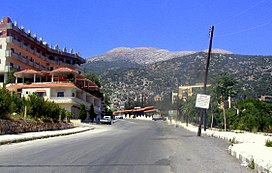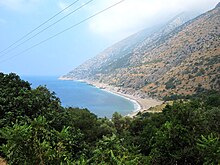Jebel Aqra
| Jebel Aqra | |
|---|---|
| جبل الأقرع | |
 Jebel Aqra overlooking the town of Kessab | |
| Highest point | |
| Elevation | 1,717 m (5,633 ft) |
| Coordinates | 35°57′9″N 35°58′9.5″E / 35.95250°N 35.969306°E |
| Geography | |
| Location | |
Jebel Aqra (
The mountain was a cult site in
Names
The ancient
The Hurrians and the Hittites respectively called the mountain Ḫazzi (𒄩𒊍𒍣) and Ḫazi (𒄩𒍣), which was a name also used for it in early Akkadian texts.[2] The Hurro-Hittite name gave rise to the mountain's Ancient Greek name of Kásion (Κάσιον).[3]
Zaphon, like Mizpah and Mizpeh, is derived from a noun meaning lookout point.[4]
History
Jebel Aqra has a long history as a sacred mountain.[5][6]
The
The ancient port of
It appears in the
Under
The cult of the god of the mountain was transferred, by interpretatio graeca, to Zeus Kasios, the "Zeus of Mount Kasios", similar to Ras Kouroun in the Sinai. Tiles from the Greco-Roman sanctuary at the site, stamped with the god's name, were reused in the Christian monastery that came to occupy the eastern, landward slopes of Kazios.[21]


When kings and emperors climbed Mount Kasios to sacrifice at its
Greek theophoric names Kassiodora and Kassiodorus,[23] equally a "gift of Kasios", recall a vow of one or both parents made to ensure fertile conception.[24]
Christian hermits were drawn to the mountain; Barlaam challenged its demons by founding a monastery near the treeline on its eastern slopes, and Simeon Stylites the Younger stood for forty years on a pillar near its northern flanks until his death in 592.
The cult site is represented by a huge mound of ashes and debris, 180 feet (55 m) wide and 26 feet (7.9 m) deep, of which only the first 6 feet (1.8 m) have been excavated. Archaeologists only reached as far as the Hellenistic strata before the site was closed, as it lies in a Turkish military zone on its border with Syria.[7]
Notes
- ^ Bar Daroma claimed it as the northern Mount Hor (Hebrew: הר ההר)[13] mentioned in the Book of Numbers,[14] although this is more often taken to refer to Turkey's Nur Mountains.[15]
References
Citations
- ^ van Soldt 2009.
- ^ Röllig 1975.
- ^ Astour, Michael C. [in Ukrainian] (1965). Hellenosemitica: An Ethnic and Cultural Study in West Semitic Impact on Mycenaean Greece. Leiden, Netherlands: Brill Publishers. p. 136.
- ^ Steiner 2017 The Aramaic Text in Demotic Script
- ^ DDD (1999).
- ^ Lane Fox (2009).
- ^ a b c Lane Fox (2009), p. 245.
- ^ Rutherford (2001).
- ^ Lane Fox,[7] quoting Rutherford.[8]
- ^ a b DDD (1999), p. 927.
- ^ Lane Fox (2009), p. 244.
- ^ Lane Fox (2009), p. 252.
- ^ Bar Daroma (1958), p. 180–199.
- ^ Num. 34:7–8.
- ^ Hertz (1988).
- ^ Isa. 14:13.
- ^ Gen. 13:14.
- ^ Deut. 3:27.
- ^ Ps. 48.
- ^ Lane Fox 2009:246; these cultural connections are the theme of Lane Fox's book.
- ^ Lane Fox 2009:246, noting H. Seyrig in W. Djobadze, Archaeological Investigations in the Region West of Antioch and the Orontes, 1986.
- ^ Lane Fox 2009:248f.
- ^ See Cassiodorus, born in Magna Graecia, who bears the name in its Romanized form.
- .
Bibliography
- "Zaphon", Dictionary of Deities and Demons in the Bible, 2nd ed., Grand Rapids: Wm. B. Eerdmans Publishing, 1999, pp. 927–928.
- Bar Daroma, Chaim (1958), זה גבול הארץ; גבולותיה האמתיים של ארץ ישראל לאור המקורות [Ve-zeh Gevul Ha-arets: Gevuloteha ha-Amitiyum Shel Erets Yisra'el le-'or ha-Mekorot; And This Shall Be the Border of the Land: The True Boundaries of Israel According to the Sources], Jerusalem: Hotsa'at Sefarim Be'er le-Heker ha-Mikra Veha-arets. (in Hebrew)
- Hertz, Joseph H., ed. (1988), The Pentateuch and Haftorahs, Soncino Press.
- Lane Fox, Robin (2009), "A Travelling Mountain", Travelling Heroes in the Epic Age of Homer, New York: Knopf, pp. 243–258.
- Rutherford, Ian (2001), "The Song of the Sea", Studien zu den Boghaz-Köy-Texten, No. 45, pp. 598–609.
- ISBN 978-3-110-06772-9.
- van Soldt, W. H. (2009). "Ṣapunu". In Streck, Michael P.; Frantz-Szabó, G.; Krebernik, M; Morandi Bonacossi, D.; ISBN 978-3-110-20384-4.

